Southwest Michigan field crops update - September 8, 2022
Corn and soybean are entering the final stages of grain fill. Dry conditions have kept disease pressure low, but hopefully the crop will have enough water to get to the finish line.

Weather
Temperatures this past week were 2-4 degrees warmer than normal on average in the southwest. We are still roughly a week ahead on heat units and picked up 195 growing degree days (GDD, base 40 for alfalfa) or 125 GDD50 (for corn and soybean) this past week at the Kalamazoo Enviroweather station. The forecasted reference evapotranspiration (FRET) rate will be slightly lower than normal for this time of year at 0.8-0.9 inch this coming week. The forecast predicts the addition of 180 GDD40 or 115 GDD50 in the coming week. Both the 6-10 day and 8-14 day outlooks call for above-normal temperatures for Sep. 13-21.
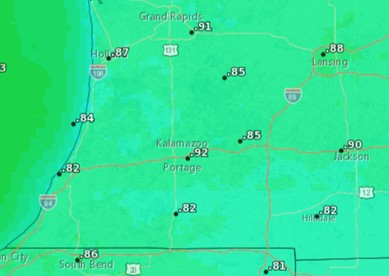
Precipitation this past week was meager once again with most areas receiving less than a quarter inch. The region has been very dry overall over the past two weeks with 1-2 inches below normal rainfall for the southern two tiers of counties. Several high-pressure centers perched over the Midwest will bring beautiful weather and near-cloudless skies over the next few days with the next chance of rain likely on Sunday. The forecast is for another drier than normal week with less than 0.75 inch for most of the region, all of that predicted Sunday through early Tuesday. The medium-range outlooks both call for near-average chances of precipitation during the middle of September.

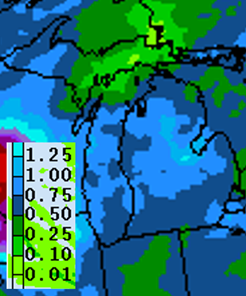
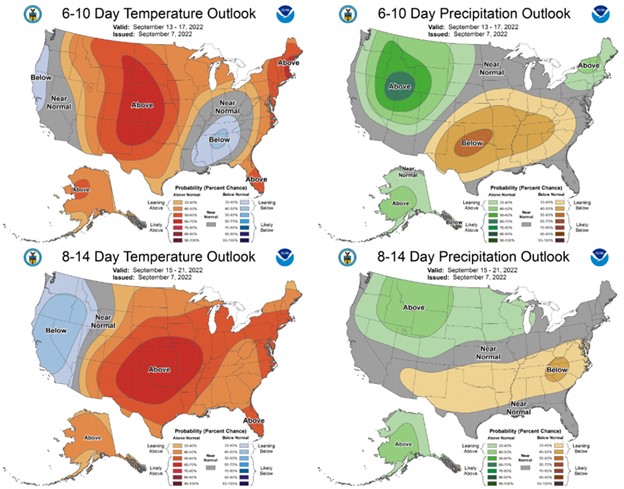
Crops and Pests
Corn and soybean continue to look very good entering the final stages of grain fill with both being rated at 66% good to excellent in Michigan according to the latest USDA Crop Report. Corn ranges from beginning dent to late dent (R5) throughout the region and 8% of the corn in the state has reached maturity. Corn requires roughly 350 GDD50 to progress from beginning dent to full dent and another 250 GDD50 to black layer. Corn at 1/2 to 2/3 milk line are ready for silage chopping depending on storage plans (slightly earlier for well-packed bunker silos). Soybeans are at full seed (R6, pod containing a green seed that fills the pod capacity at one of the four uppermost nodes on the main stem) and several fields have begun leaf drop although I have not found any mature pods yet.
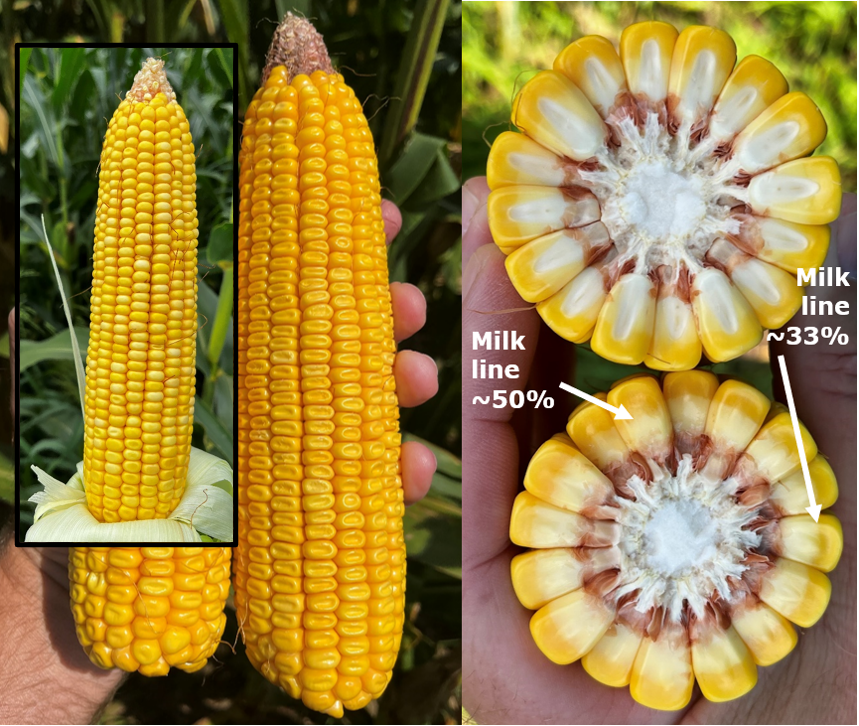
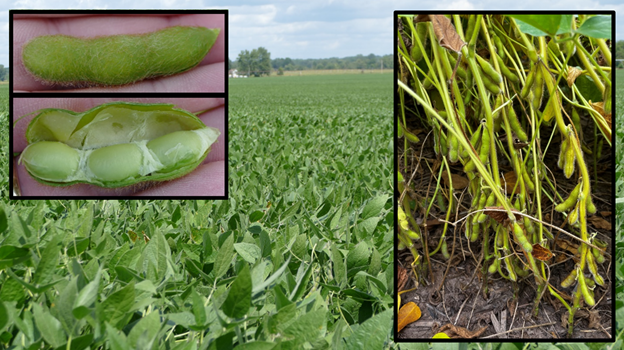
Forages
The final alfalfa cuttings should be coming off now as harvesting later into September will increase the risk of impacting winter survival.
Diseases
Tar spot in corn was reported in the first half of August in Allegan, Eaton, and Van Buren counties and in the last half of August in Branch and Hillsdale counties. With the dry conditions recently, incidence and severity of tar spot has remained low throughout the region, and as we near the end of the dent stage, we can expect minimal impact on yield this year. The only diseases seen to date are northern corn leaf blight (low severity), Septoria brown spot in soybean (not normally a concern) and sudden death syndrome (SDS) in several soybean fields. Scout now if your fields have not yet begun to turn yellow to identify incidence and severity of SDS and make appropriate variety and seed treatment decisions for next year.
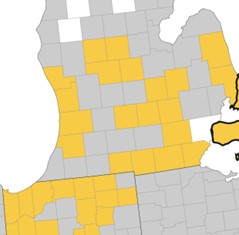
Irrigation
Corn at beginning dent (R5) has a Kc (crop water use coefficient) of 1.2 and will require 1.0-1.1 inches this week. The Kc for corn at full dent is 1.0, and at black layer (physiological maturity) it will be 0.66. Soybean at R6 (full seed) also have a Kc of 1.2 and that will drop to 1.0 once pods begin turning their mature color. Corn and soybean beyond these stages will require only 0.9 inch this week.
The goal of the soybean irrigator should be to maintain at least 50% of available soil water holding capacity for soybeans until most pods yellow. Corn producers trying to maintain test weight in dry late summer conditions should maintain at least 50% of the available soil water holding capacity until the crop reaches black layer.
For more information, check out the MSU Extension article, “End of season irrigation decisions.”
Reducing soybean harvest losses was the topic of this week’s MSU Extension Field Crops Virtual Breakfast with soybean senior educator Mike Staton. Harvest losses can be attributed to one or more factors including equipment selection, maintenance and adjustment and harvest timing and speed. Staton provided several details about each factor—here are just a few of those.
- Make sure all knife sections are sharp and tight with ≤ 1/32-inch gap between knife and hold-downs
- Consider purchasing a draper head to maximize threshing capacity and allow for faster ground speeds
- Consider purchasing an air-assist reel to increase efficiency, especially with short plants
- Begin harvesting at 15-16% moisture as the economics favor harvesting a few percentage points above 13% over a few points below which is the ideal goal
- Consider harvesting closer to 3 mph to reduce risk of losses
- Pay attention to reel speed and adjust on the fly if possible, aiming for 10-25% faster than ground speed in good conditions and 50% faster than ground speed in lodged (fallen) conditions
Harvest losses can be due to pre-harvest pod drop or shatter, beans growing below the cutter bar height, lodged plants or tangled/matted plants, shatter at the combine head, and losses out the back of the combine. Making observations before and after harvesting a strip will help to assess where adjustments may need to be made. Harvest a strip at least 300 feet long and then back up about 20 feet. Count the number of loose beans and beans in pods per square foot in the standing crop ahead of the harvested area. Then count at several locations across the header width roughly 20 feet back from the leading edge of the harvested strip and again behind the combine. Four beans found per square foot roughly equal one bushel of loss.
The MSU Extension Soybean Harvest Equipment Field Day will provide participants with new information and educational materials about reducing soybean harvest losses. Equipment company representatives will discuss specific recommendations for fine-tuning their combines. The free event will be held at 2845 130th Avenue in Allegan, MI, beginning with registration and a complimentary lunch at 11:30 a.m. and concluding at 3:30 p.m. Preregistration is requested by calling (269) 673-0370 ext. 2562 before noon on Friday, September 9th to ensure an accurate count for lunch and educational materials. Please call this same number and extension for cancellation and rescheduling information.
If you were not able to join the session, the recordings will be closed-captioned and available at the Field Crops Virtual Breakfast webpage and the MSU Extension Field Crops Team social media platforms: Facebook, Spotify, YouTube, Apple Podcasts and Twitter.



 Print
Print Email
Email